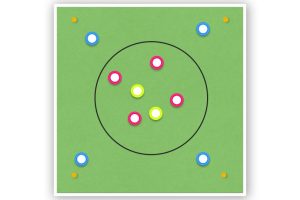Successful Soccer Coaching Interventions
Coaching intervention in soccer is a crucial strategy used by coaches to enhance player performance and understanding of the game.
Soccer is a dynamic sport that calls for a unique blend of individual skills and team tactics. Hence, coaches often need to step in during practice to correct, instruct, and inspire their players.
These timely interventions can focus on technical skills, tactical knowledge, or motivational aspects, depending on what the coach observes during training sessions. A coach might pause the entire practice to demonstrate a more effective way to execute a pass. Alternatively, they might pull aside an individual player to correct their shooting technique.

Sometimes, interventions are necessary to ensure that players understand the strategic elements of soccer, such as positioning and movement off the ball.
Coaches must decide the right moment to interject so as not to disrupt the flow of practice or undermine player confidence.
Communicating effectively during these interruptions is vital to ensure that the message is clear and constructive. Furthermore, knowing when not to intervene is just as important, as giving players the freedom to learn from their mistakes can be an invaluable part of their development.
Key Takeaways
- Interventions are strategic pauses in practice for skill and knowledge enhancement.
- Effective communication and demonstration by the coach are key during interventions.
- The timing and necessity of an intervention are critical for player development.
Understanding the Role of Coaching Interventions
Soccer coaching interventions are critical moments when a coach decides to halt practice to provide immediate feedback or instruction. These moments are pivotal for teaching and can greatly influence player development and understanding of the game.
Interventions should be timely and based on specific needs, such as correcting a player’s technique, clarifying tactical knowledge, or reinforcing positive behavior.
Types of Interventions:
- Technical: A coach may stop a session to correct or enhance a player’s technical skills, such as passing or dribbling.
- Tactical: If players misunderstand their roles or a certain strategy, the coach can clarify these elements.
- Psychological: Sometimes a coach needs to intervene to boost morale or confidence.
Coaches should consider the following when deciding to intervene:
- Timing: Choose a moment that is natural to pause, like after a drill completion.
- Brevity: Keep the intervention short and to the point to maintain players’ attention.
- Clarity: Communicate clearly and ensure understanding.
- Demonstration: Sometimes, showing is better than telling. When a visual demonstration is needed to correct or instruct a technique or tactic, coaches should lead by example.
Interventions should not disrupt the flow of the practice excessively and ought not to undermine players’ confidence. They should pursue a balance—ensuring that players are provided with enough freedom to learn from their own mistakes, yet giving them the crucial guidance to make necessary improvements. Using a methodological approach can enhance the effectiveness of these interventions.
Timing of Interventions

Effective coaching interventions are not just about what is taught, but also about when the instruction is inserted into the flow of practice. Timing is crucial to maximize player development and understanding.
Recognizing Teachable Moments
A coach needs to keenly observe both the player’s performance and their readiness to learn to identify teachable moments. These moments can arise when a player demonstrates incorrect technique, when a new concept is being introduced, or when an error consistently affects gameplay.
It’s imperative that coaches intervene when the mistake is fresh and the learning opportunity is highest.
Balancing Flow and Instruction
Maintaining the flow of the practice session is important, but so is providing targeted instruction.
Coaches should ensure that their interventions are concise and focused, so players can quickly apply the new knowledge.
The balance is delicate: too many interruptions can frustrate players and impede momentum, while too few may miss critical learning opportunities. Coaches should ask themselves if the intervention will add immediate value; if not, they may choose to address it later.
Methods of Intervention
Effective soccer coaching interventions can transform a practice session and elevate player performance. Knowing when and how to step in is crucial for fostering player understanding and skills.
Direct Demonstration
A coach intervenes through Direct Demonstration when they show players exactly how to perform a technique or tactic. This is most effective for visual learners and when introducing new skills.
It is crucial to perform the demonstration correctly as players will mimic precisely what they see.
Guided Discovery
In Guided Discovery, a coach poses challenges or sets up scenarios that lead players to learn by exploring and solving problems.
This approach encourages players to think critically and understand the ‘why’ behind their actions, fostering deeper learning and creativity on the field.
Question and Answer
Using the Question and Answer technique, a coach intervenes by asking targeted questions that prompt players to reflect on their decisions and actions.
This helps develop players’ game intelligence and decision-making skills. It’s essential to ask open-ended questions that stimulate thought rather than simple yes/no answers.
Individual Feedback
Individual Feedback focuses on providing personal, specific input to a player.
Coaches should balance positive reinforcement with constructive criticism to help players understand their strengths and areas for improvement.
It’s important to keep feedback timely and relevant to the player’s immediate actions.
Group Discussion
Lastly, Group Discussion invites players to share their insights and learn from each other’s experiences.
This collaborative approach helps build team cohesion and collective understanding.
Coaches should facilitate discussions that are inclusive and focused on the session’s objectives.
Effective Communication During Interventions

When a coach decides to interrupt a soccer practice with an intervention, clear communication is critical. It is essential for coaches to gauge the moment correctly—knowing when and how to jump in is a skill developed through experience.
Before intervening, they must quickly assess whether the stoppage will benefit the entire team or just a single player.
During a team-wide intervention, the coach should ensure that the message is concise and relevant to the recent action or tactic.
It is vital that they maintain engagement with all players, using language that is easily understood and avoiding technical jargon unless it’s already familiar to the team.
In a one-on-one intervention, personalized feedback is necessary.
Coaches may pull the player aside to avoid embarrassment and speak specifically about the technique, tactic, or action that needs improvement.
This moment is for constructive criticism, ensuring the player understands the objective perspective without feeling demoralized.
Interventions should occur if a coach observes:
- Repeated errors that need correcting
- Opportunities to reinforce positive behavior
- Situations where safety may be compromised
- Teachable moments that can enhance player understanding
Coaches should avoid intervention if:
- It disrupts the flow of a good practice session
- It concerns a minor, correctable mistake
Coaches can make use of visual aids, like field diagrams, or actively demonstrate techniques to enhance understanding.
Here are tactical interventions:
| Type of Intervention | Reason |
|---|---|
| Tactical | To adjust team strategy. |
| Technical | To improve a player’s skill set. |
| Psychological | To boost morale or confidence. |
| Physical | To ensure correct posture. |
Intervention Do’s and Don’ts

Effective soccer coaching hinges on knowing when to interrupt a drill to make a critical point and when to let play continue. Here’s how to balance intervention for optimal player development.
Dos: Encouragement and Focus
Do intervene with purpose: If a coach sees a player consistently making the same mistake, it’s vital to step in and correct it.
By stopping the play and addressing the error immediately, the player can be shown the correct technique, which they can then practice to solidify their understanding.
For instance, if a player is persistently misjudging long passes, a coach might freeze the play and walk through the mechanics of properly striking the ball, emphasizing body position and timing.
Do use positive reinforcement: When a coach interjects, they should employ encouragement and focus.
They should highlight what the player is doing well, alongside what needs improvement.
Always start with a positive note, such as acknowledging a good attempt or effort before suggesting a way to improve technique or decision-making.
This approach not only promotes a positive atmosphere but also makes players more receptive to feedback.
Don’ts: Undermining Confidence and Overloading
Don’t intervene too frequently: A coach should avoid interrupting too often, as it can break the flow of the practice and can lead to undermining player confidence.
If players are afraid to make mistakes because they anticipate being called out, they may become hesitant and unable to play naturally.
Instead, coaches should allow play to continue through minor errors, addressing them later unless they are critical to the game’s flow.
Don’t overload players with information: When a coach decides to step in, they should deliver concise and focused instructions.
Players can become overwhelmed if they are given too much information or too many corrections at once, leading to confusion and frustration.
Coaches should aim to correct one or maybe two aspects of play at a time, thus helping players to absorb and apply the feedback effectively.
Assessing the Impact of Interventions

When a coach decides to interrupt a soccer practice to give feedback or demonstrate a skill, the effectiveness of this intervention should be carefully evaluated.
To determine the effectiveness of these coaching interventions, coaches can look at several key areas:
- Athlete’s Skill Improvement: Has the technical ability of the players improved following the intervention?
- Understanding of Tactical Concepts: Are players better able to execute team tactics and make smart decisions during play?
- Athlete’s Motivation: Do players show increased enthusiasm and effort in training sessions after the intervention?
- Team Cohesion: Does the team work together more cohesively as a unit?
To systematically analyze the impact, coaches could use the following methods:
- Observation:
- Post-Intervention: Watch for immediate changes in performance.
- Over Time: Monitor changes across several sessions.
- Feedback:
- Surveys: Gather player’s perceptions about the coaching effectiveness.
- Discussions: Conduct one-on-one or team discussions to get direct feedback.
- Performance Metrics:
- Qualitative: Assess players’ technique, decision-making, and teamwork.
- Quantitative: Look at measurable data such as goals scored, pass completion rates, or distance covered.
Follow-Up After Interventions

When soccer coaches conduct an intervention during a practice, the follow-up is crucial for reinforcing the lessons taught.
Immediate Reinforcement
- After the intervention, watch carefully for when players apply the new knowledge.
- Praise players when they correctly implement the instruction, reinforcing positive behavior.
Reflective Practice
- Encourage players to think about the changes they’ve made.
- Ask open-ended questions to promote self-assessment and reflection.
Subsequent Training Sessions
- Begin the next practice with a review of the previous intervention.
- Use repetitive drills focusing on the skill or tactic that was the subject of the intervention.
Peer-to-Peer Learning
- Pair players up to discuss their experiences and thoughts regarding the intervention.
- Foster an environment where peer feedback is valued and respected.
Documentation and Analysis
- Keep a record of interventions and their outcomes.
- Review these notes before future practices to tailor your coaching strategy.
Continual Assessment
- Monitor progress over multiple sessions to gauge the effectiveness of the intervention.
- If necessary, make amendments or provide additional instruction.
Frequently Asked Questions

In the dynamic field of soccer coaching, the implementation of well-timed and strategic interventions is essential. This FAQ section is intended to provide insights based on specific scenarios and queries commonly raised by soccer coaching professionals.
What tactics can you use to effectively demonstrate a skill during a soccer practice?
Coaches often employ the tactic of ‘freeze play’ to take a momentary pause during practice and demonstrate a skill. They may also step in to role-play a particular scenario—ensuring they break down the skill into visible and easy-to-understand steps. Using visual aids such as cones and diagrams can further enhance understanding.
What are the key moments to intervene during a soccer training session to correct player techniques?
Intervention should be considered when persistent errors occur or when a player demonstrates a lack of understanding of the given instructions. Key moments include when a player’s technique may lead to injury or when an error is a teachable moment for the whole team.
How can a soccer coach with no prior experience implement coaching interventions?
New coaches can start by observing experienced coaches to understand the timing and methods of effective interventions. They should also familiarize themselves with the basic rules and techniques of soccer, and begin by addressing overarching concepts before moving to individual critiques.
In coaching young soccer players, when is the most effective time to step in and guide them?
Guidance is most effective when a child is mentally prepared to receive and implement feedback, typically after they’ve had a chance to attempt the skill themselves. Always intervene in a supportive manner that maintains the young player’s confidence and encourages them to try again.
Can you provide examples of successful interventions used by coaches in youth soccer?
Successful interventions include the use of scrimmage modifications to emphasize particular skills, implementing targeted drills to correct common mistakes, and using positive reinforcement to commend good technique, thus reinforcing correct playing habits.
What are the best practices for teaching soccer tactics to children under the age of 10?
When coaching under-10 players, it is best to focus on simple, fun, and engaging activities that build basic skills.
Creating a positive experience is central. Use games that encourage passing, dribbling, and shooting. Then, gradually introduce the basic rules and tactics of soccer.






